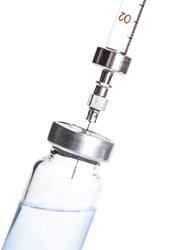Achieving Clinical And Financial Benefits From Vaccination Programs

Five best practices that fueled SwedishAmerican Health System’s success.
By Jennifer Kuroda, Quality Improvement Manager, SwedishAmerican Health System — A Division of UW
While vaccinations in the U.S. are low for pneumococcal pneumonia, incidences of the disease are not: nearly one million adults contract the disease every year. Senior adults or high-risk populations — for instance, patients with congestive heart failure or diabetes — frequently have long-term or complex cases of pneumococcal pneumonia.
Healthcare organizations have many critical reasons to implement proactive protocols for pneumococcal vaccinations. In addition to the obvious benefits for patient health, these vaccinations are a high-profile quality measure for senior adults relating to CMS ACO measure 15, National Quality Forum (NQF) measure 0043, and an NCQA Healthcare Effectiveness Data and Information Set (HEDIS) measure. A pneumococcal vaccination program can yield many positive results, enabling healthcare organizations to provide preventive care and lower healthcare costs while meting quality measures.
Leadership at SwedishAmerican Health System — A Division of UW and SwedishAmerican Medical Group (SAMG) recognized the need for a comprehensive pneumococcal vaccination program that would educate clinicians and patients, facilitate better clinical outcomes, and promote preventive care—especially for senior adults. For this reason, we joined the AMGA Foundation’s Adult Immunization (AI) Best Practices Learning Collaborative, a 14-month program designed to help improve vaccination rates. Through the program, we’ve increased pneumococcal vaccinations in the 65 and over population by 20 percent.
SAMG’s program also addressed pneumococcal pneumonia vaccinations as well as influenza vaccinations for certain high-risk populations; however, our initial focus was to ensure senior adults received a series of two pneumococcal vaccinations. The Immunization Action Coalition recommends administering two vaccinations, PCV13 and PPSV23, eleven months apart.
SAMG’s immunization program focused on several key elements to ensure integration and adherence of the vaccination protocol throughout the entire organization, including:
- educating clinicians and patients on the importance of these immunizations
- training clinicians on what to say and when
- supporting clinicians’ efforts by incorporating vaccination prompts and reminders within their workflow
Incorporating these elements required widespread communication throughout all of SwedishAmerican’s ambulatory locations. In addition, all clinicians and staff needed training and support so they could add pneumococcal vaccinations to their workflow. To that end, SAMG leveraged five best practices to help fully integrate the immunization program and ensure its success.
5 Best Practices To Ensure Vaccination Program Success
- Integrate physician engagement and education within the existing structure: By leveraging our existing meeting structure, SAMG achieved widespread culture change among both clinicians and office managers. The initial education began in our quality committee. As program champions, this committee was passionate about sharing the information in the clinics. Quality committee members were also responsible for disseminating information to any other committees in which they had served. Additionally, there is a monthly SAMG provider meeting where attendance is required, offering the ideal opportunity to educate the entire group on the details of our immunization program.
In short, SAMG used all relevant meetings to ensure the immunization program information was disseminated as widely as possible. Although this meant certain providers received the information multiple times, we believed the repetition would be helpful in reinforcing the initiative’s importance.
- Align incentives to drive performance: Providers are driven by monetary incentives and healthy competition; thus, SAMG added the pneumococcal 65+ measurement to both its quality and physician compensation scorecards. By tying vaccination rates to compensation, physicians were encouraged and rewarded for educating and vaccinating patients. The quality scorecard is also published on a monthly basis across the organization. This transparency fuels a competitive nature and facilitates greater accountability and adherence.
- Implement a daily care gap report: SAMG follows the Patient-Centered Medical Home model; therefore, each clinic conducts a daily huddle and reviews a daily care gap report. This report lists all patients with appointments that day and specifically identifies gaps in care for these patients. As a part of our Adult Immunization Collaboration, this report now gives our clinical team actionable information about patients who need vaccinations, including if the patient had one or both of the immunizations. It also uses the algorithm to determine the appropriate timing, if a second immunization is required. This report acts as a cheat sheet, providing point-of-care information providers need to ensure each patient receives comprehensive care.
- Leverage the EHR to support vaccination efforts: Originally, some clinicians were confused about the timing of the two vaccinations. SAMG developed protocols to facilitate ordering and administering vaccinations for senior adults, incorporating an algorithm into our EHR. The EHR now provides prompts and reminders to guide physician discussions with patients. This enables our physicians to better educate patients about what vaccinations they need and why.
- Include in-room signage: SAMG’s patient education effort included in-room signage in all primary care clinic exam rooms. The simple, straightforward message was, “Are you 65 or older? Did you know you need two pneumococcal pneumonia vaccinations?” As a result, patients asked their physicians about the vaccinations. In the past, SAMG’s signage for other initiatives was less effective. By integrating numerous patient education initiatives such as increased patient/nurse and patient/physician discussions along with the signage, SAMG increased the program’s effectiveness.
Leveraging Quality Measures To Meet Financial And Patient Care Goals
SAMG has retained the pneumococcal 65+ measurement, also expanding its focus toward high-risk patients. Program signage is still in place, prompting meaningful discussions between patients and physicians. Our vaccination rates continue to increase.
Programs that support quality initiatives will continue to grow in importance as value-based reimbursement eclipses fee-for-service. The 65+ demographic is especially important. As baby boomers continue to age, their healthcare needs become more costly and complex. A pneumococcal vaccination program supports preventive care for seniors, facilitating quality initiatives while also meeting population health goals. Its benefits include better financial and clinical outcomes, and it helps senior adults take an important step toward better health and preventive care.
